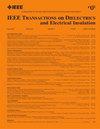Mechanism of Copper Sulfide Deposition on Oil-Paper Insulation Partial Discharge Under Extremely Uneven Electric Field
IF 2.9
3区 工程技术
Q2 ENGINEERING, ELECTRICAL & ELECTRONIC
IEEE Transactions on Dielectrics and Electrical Insulation
Pub Date : 2024-09-23
DOI:10.1109/TDEI.2024.3466113
引用次数: 0
Abstract
The corrosive sulfur in transformer oil reacts with the copper winding to form copper sulfide (Cu2S) deposits, which cause partial discharge (PD) and accelerate the degradation of the oil-paper insulation. Currently, the mechanism of the influence of Cu2S deposition on PD is not clear. This article presents a simulation model for oil-paper insulation PD with Cu2S depositions under point-plane electrodes and studies the PD process and the influence law on PD at different distributions of Cu2S deposits under extremely uneven electric fields. The findings indicate that the presence of Cu2S deposits enhances the intensity of the electric field within the oil gap, thereby expediting the progression rate of the streamer. Upon reaching the Cu2S surface, the streamer will cause severe surface discharge. Increasing the deposition width is beneficial for the diffusion of charge on its surface but not the accumulation of charge. The surface charge density of Cu2S deposition with a large width climbs more slowly, the smaller the peak, and the smaller the final density level maintained. Meanwhile, the increase in deposition thickness not only shortens the streamer’s diffusion distance and increases the electric field intensity within the oil gap, but also reduces the onset and development time of surface discharge. Within a certain distance range, Cu2S deposition generates more charge when discharged away from the surface of the needle tip. The studies of PD under the influence of Cu2S deposition partially reveal the physical process and influencing factors of Cu2S-induced PD. This information is instrumental in developing a more accurate deposition detection method and is conducive to the optimization of the insulating structure and the research on the technology of suppressing PD.极不均匀电场条件下油纸绝缘局部放电中硫化铜沉积机理研究
变压器油中的腐蚀性硫与铜绕组发生反应,形成硫化铜(Cu2S)沉积物,引起局部放电(PD),加速油纸绝缘的降解。目前,Cu2S沉积对PD的影响机制尚不清楚。建立了点平面电极下Cu2S沉积油纸绝缘局部放电的仿真模型,研究了极不均匀电场下不同Cu2S沉积分布下的局部放电过程及其对局部放电的影响规律。研究结果表明,Cu2S沉积物的存在增强了油隙内电场的强度,从而加快了拖缆的推进速度。流光到达Cu2S表面后,会造成严重的表面放电。增大沉积宽度有利于电荷在其表面的扩散,而不利于电荷的积累。宽度较大的Cu2S镀层表面电荷密度爬升较慢,峰值越小,最终保持的密度水平越小。同时,沉积厚度的增加不仅缩短了流线的扩散距离,增加了油隙内的电场强度,而且缩短了表面放电的发生和发展时间。在一定距离范围内,Cu2S在远离针尖表面放电时产生更多的电荷。Cu2S沉积对PD影响的研究部分揭示了Cu2S诱导PD的物理过程和影响因素。这些信息有助于开发更精确的沉积检测方法,有利于绝缘结构的优化和抑制PD技术的研究。
本文章由计算机程序翻译,如有差异,请以英文原文为准。
求助全文
约1分钟内获得全文
求助全文
来源期刊
CiteScore
6.00
自引率
22.60%
发文量
309
审稿时长
5.2 months
期刊介绍:
Topics that are concerned with dielectric phenomena and measurements, with development and characterization of gaseous, vacuum, liquid and solid electrical insulating materials and systems; and with utilization of these materials in circuits and systems under condition of use.

 求助内容:
求助内容: 应助结果提醒方式:
应助结果提醒方式:


